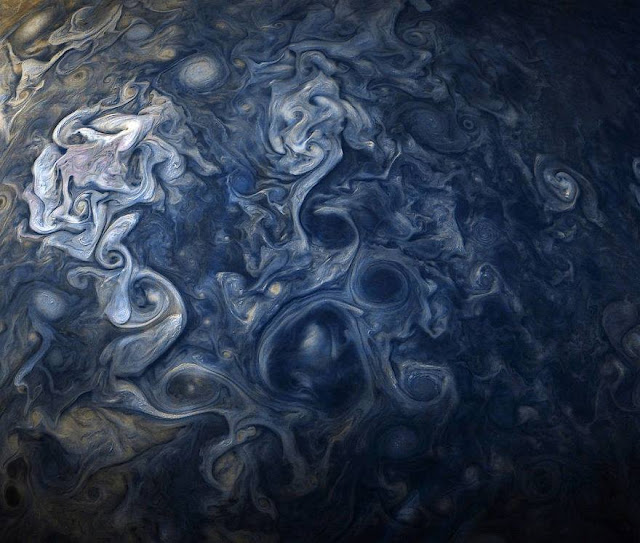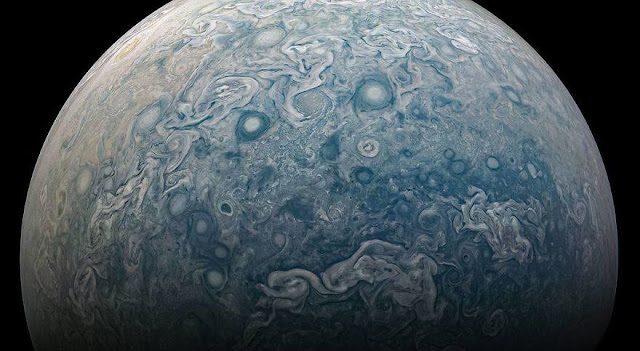It’s at a time like this, when millions of people across the world are heeding shelter in place orders, that we start missing the things were able to do freely before. Things we took for granted, like taking a walk in the park, meeting with friends, or finding a good spot to watch the moon and stars on a clear night are difficult, if not impossible, to do now.
Thankfully, through social media we can still chat with our friends, work, study, and explore the great, vast and fascinating universe. Those stuck indoors can take the opportunity to discover and learn about NASA’s ongoing research in space, going where man has yet to go… and they’re working hard on making that a reality for the future.
 |
| The Great Red Spot and tempestuous southern hemisphere taken by NASA’s spacecraft Juno during a nearby pass of this great gas planet |
Meanwhile, NASA has gone far, far away since landing man on the moon. To name just a few achievements, this year celebrates 20 years of the International Space Station orbiting Earth; the Hubble Space Telescope, launched in 1990, has provided mind blowing images of planets and galaxies; and the Curiosity Rover was launched on November 26, 2011 and landed on Mars on August 6, 2012 to determine whether Mars was ever able to support microbial life.
 |
Jupiters’ southern hemisphere is totally overtaken by these whirling cloud belts in the image taken by NASA’s spacecraft Juno.
|
 |
| An extraordinary image captured of 2 storms merging together taken from NASA’s spacecraft Juno of Jupiter’s atmosphere |
 |
| Nearby the South Pole of Jupiter, twirling cloud configurations are captured looking upwards to the equatorial area. |
NASA’s New Frontiers Program is particularly exciting and started with the launch of the New Horizons on January 19, 2006, passing Jupiter in February 2007, and conducting a six-month-long flyby study of Pluto and its moons in the summer of 2015, providing amazing images and, pending approval, is expected to venture further into the Kuiper Belt to examine other icy mini worlds, estimated to be at least a billion miles beyond Neptune’s orbit.
Juno is the second spacecraft designed for the New Frontiers Program and successfully launched on August 5, 2011, some deep space maneuvers and an Earth flyby gravity assist in October 2013, Juno finally arrived at Jupiter in July 2016 and has been photographing the gigantic planet for scientific research ever since.
Juno’s pictures of Jupiter, 484 million miles away from Earth, were released recently, showing a captivating sight of the planet’s southern hemisphere. This mesmerizing picture of Jupiter was just a taste which led to a series of other enchanting pictures of this fascinating planet.
 |
| The Jovian cloudscape is dominated by a vigorous storm on the southern edge of Jupiter’s northern polar region |
 |
| A striking image of Jupiter’s distinct Great Red Spot and the enfolding turbulent areas captured by NASA’s spacecraft Juno. |
 |
| Complex and intriguing patterns in a jet stream region of Jupiter’s northern hemisphere known as “JetN3” are taken from NASA’s Juno spacecraft. |
 |
| During a flyby of the gas giant on the 16th of December 2017, the abundant white clouds are seen in this picture of Jupiter’s equatorial zone. The infrared measurements of water are further complicated by these clouds, but at microwave frequencies these same clouds are opaque and allow for Juno’s Microwave Radiometer to record water hidden deeply in Jupiter’s atmosphere |
 |
| Captured with Jupiter’s northern hemisphere, turbulent and twirling cloud bands are depicted in what could look like a water colour painting at first glance! |
 |
| A whirlpool with a deep dark core is clearly depicted in this image of a view of an area inside a Jovian jet stream. The vivid high altitude clouds are featured too in this intriguing image captured by Juno, NASA’s spacecraft. |
 |
| On the 21st of December 2018 this stunning image of the southern hemisphere of Jupiter was taken from Juno, NASA’s spacecraft on nearby flyby of the gas planet |
 |
| Turbulent northern areas are captured by Juno, NASA’s spacecraft on the close advance on the 17th of February 2020 |
 |
| Remarkable hues of blue are depicted in this image of Jovian clouds taken by NASA’s spacecraft, Juno. |
 |
| A stunning image of Jupiter’s moon Io, generating its shadow onto the planet. Same as Earth when solar eclipses are experienced, is when Io passes in front of the Sun on Jupiter. |
 |
| Jupiter does not have a dense surface like Earth and data collected by NASA’s spacecraft Juno, has revealed that this massive planet’s winds are longer and stronger comparable to those on Earth. On this 24th trip past Jupiter, Juno photographed this incredible commotion of a wild area of this planet. |
 |
Known as a white oval, these are images of “pop-up” swirling clouds that emerge in an anticyclonic storm. Captured by NASA’s spacecraft Juno, in Jupiter’s vibrant North North Temperate Belt
|


















